Comprehensive Analysis: Benefits of Implementing a Circular Economy
VerifiedAdded on 2020/04/07
|6
|2033
|45
Report
AI Summary
This report delves into the concept of a circular economy, contrasting it with traditional linear economic models. It defines the circular economy as a system designed to minimize waste and maximize resource utilization through strategies like product life extension, product-as-a-service models, and the use of local materials. The report highlights the various benefits of adopting a circular economy, including reduced manufacturing costs, increased profitability, and enhanced environmental sustainability. Several case studies of businesses like Levi's, Dell, and Thread are discussed to demonstrate the practical application and advantages of circular economy principles. The report emphasizes that businesses can benefit from reduced raw material costs, lower transportation expenses, and a positive impact on their brand reputation. It concludes that embracing the circular economy is essential for future business success and environmental responsibility, advocating for the integration of sustainability into business strategies.
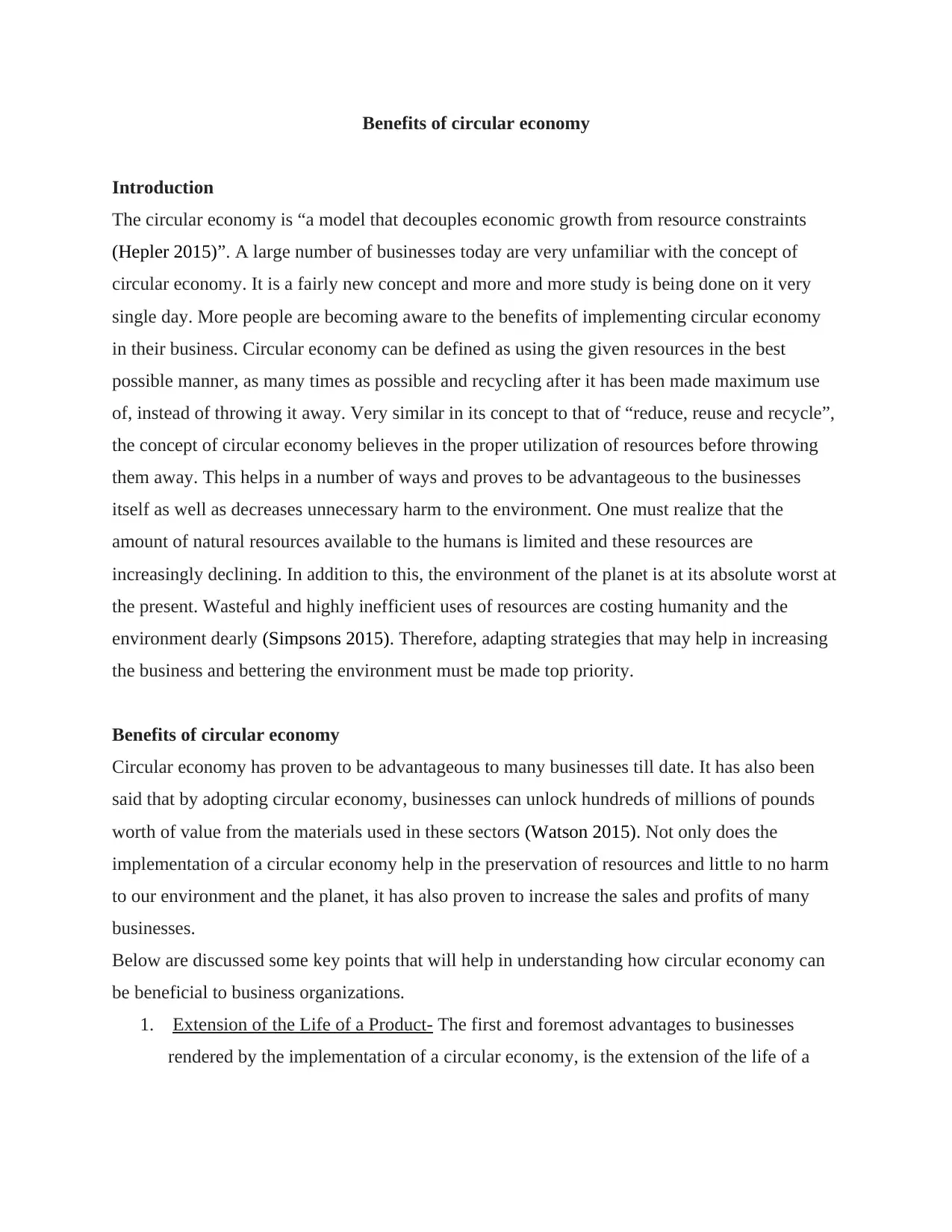
Benefits of circular economy
Introduction
The circular economy is “a model that decouples economic growth from resource constraints
(Hepler 2015)”. A large number of businesses today are very unfamiliar with the concept of
circular economy. It is a fairly new concept and more and more study is being done on it very
single day. More people are becoming aware to the benefits of implementing circular economy
in their business. Circular economy can be defined as using the given resources in the best
possible manner, as many times as possible and recycling after it has been made maximum use
of, instead of throwing it away. Very similar in its concept to that of “reduce, reuse and recycle”,
the concept of circular economy believes in the proper utilization of resources before throwing
them away. This helps in a number of ways and proves to be advantageous to the businesses
itself as well as decreases unnecessary harm to the environment. One must realize that the
amount of natural resources available to the humans is limited and these resources are
increasingly declining. In addition to this, the environment of the planet is at its absolute worst at
the present. Wasteful and highly inefficient uses of resources are costing humanity and the
environment dearly (Simpsons 2015). Therefore, adapting strategies that may help in increasing
the business and bettering the environment must be made top priority.
Benefits of circular economy
Circular economy has proven to be advantageous to many businesses till date. It has also been
said that by adopting circular economy, businesses can unlock hundreds of millions of pounds
worth of value from the materials used in these sectors (Watson 2015). Not only does the
implementation of a circular economy help in the preservation of resources and little to no harm
to our environment and the planet, it has also proven to increase the sales and profits of many
businesses.
Below are discussed some key points that will help in understanding how circular economy can
be beneficial to business organizations.
1. Extension of the Life of a Product- The first and foremost advantages to businesses
rendered by the implementation of a circular economy, is the extension of the life of a
Introduction
The circular economy is “a model that decouples economic growth from resource constraints
(Hepler 2015)”. A large number of businesses today are very unfamiliar with the concept of
circular economy. It is a fairly new concept and more and more study is being done on it very
single day. More people are becoming aware to the benefits of implementing circular economy
in their business. Circular economy can be defined as using the given resources in the best
possible manner, as many times as possible and recycling after it has been made maximum use
of, instead of throwing it away. Very similar in its concept to that of “reduce, reuse and recycle”,
the concept of circular economy believes in the proper utilization of resources before throwing
them away. This helps in a number of ways and proves to be advantageous to the businesses
itself as well as decreases unnecessary harm to the environment. One must realize that the
amount of natural resources available to the humans is limited and these resources are
increasingly declining. In addition to this, the environment of the planet is at its absolute worst at
the present. Wasteful and highly inefficient uses of resources are costing humanity and the
environment dearly (Simpsons 2015). Therefore, adapting strategies that may help in increasing
the business and bettering the environment must be made top priority.
Benefits of circular economy
Circular economy has proven to be advantageous to many businesses till date. It has also been
said that by adopting circular economy, businesses can unlock hundreds of millions of pounds
worth of value from the materials used in these sectors (Watson 2015). Not only does the
implementation of a circular economy help in the preservation of resources and little to no harm
to our environment and the planet, it has also proven to increase the sales and profits of many
businesses.
Below are discussed some key points that will help in understanding how circular economy can
be beneficial to business organizations.
1. Extension of the Life of a Product- The first and foremost advantages to businesses
rendered by the implementation of a circular economy, is the extension of the life of a
Paraphrase This Document
Need a fresh take? Get an instant paraphrase of this document with our AI Paraphraser
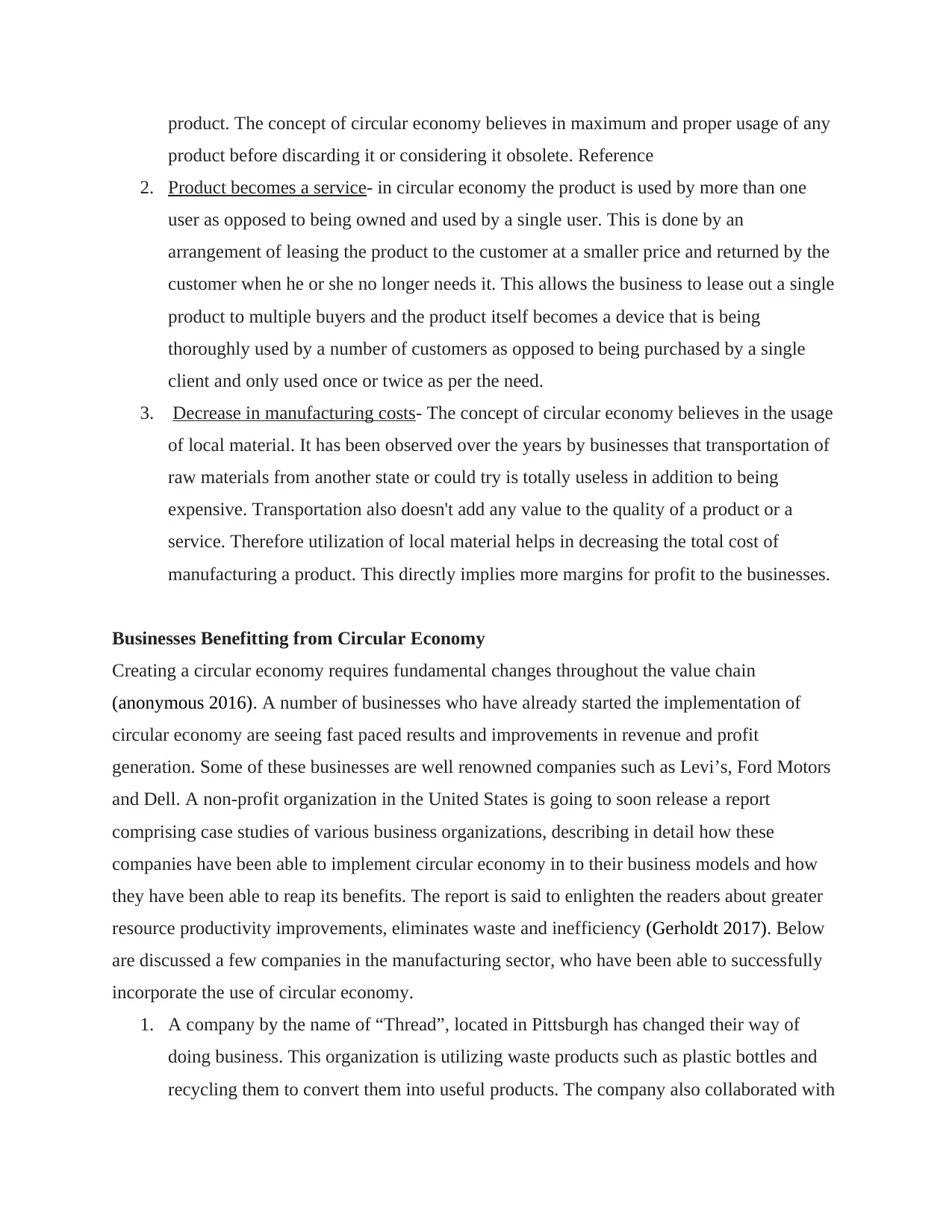
product. The concept of circular economy believes in maximum and proper usage of any
product before discarding it or considering it obsolete. Reference
2. Product becomes a service- in circular economy the product is used by more than one
user as opposed to being owned and used by a single user. This is done by an
arrangement of leasing the product to the customer at a smaller price and returned by the
customer when he or she no longer needs it. This allows the business to lease out a single
product to multiple buyers and the product itself becomes a device that is being
thoroughly used by a number of customers as opposed to being purchased by a single
client and only used once or twice as per the need.
3. Decrease in manufacturing costs- The concept of circular economy believes in the usage
of local material. It has been observed over the years by businesses that transportation of
raw materials from another state or could try is totally useless in addition to being
expensive. Transportation also doesn't add any value to the quality of a product or a
service. Therefore utilization of local material helps in decreasing the total cost of
manufacturing a product. This directly implies more margins for profit to the businesses.
Businesses Benefitting from Circular Economy
Creating a circular economy requires fundamental changes throughout the value chain
(anonymous 2016). A number of businesses who have already started the implementation of
circular economy are seeing fast paced results and improvements in revenue and profit
generation. Some of these businesses are well renowned companies such as Levi’s, Ford Motors
and Dell. A non-profit organization in the United States is going to soon release a report
comprising case studies of various business organizations, describing in detail how these
companies have been able to implement circular economy in to their business models and how
they have been able to reap its benefits. The report is said to enlighten the readers about greater
resource productivity improvements, eliminates waste and inefficiency (Gerholdt 2017). Below
are discussed a few companies in the manufacturing sector, who have been able to successfully
incorporate the use of circular economy.
1. A company by the name of “Thread”, located in Pittsburgh has changed their way of
doing business. This organization is utilizing waste products such as plastic bottles and
recycling them to convert them into useful products. The company also collaborated with
product before discarding it or considering it obsolete. Reference
2. Product becomes a service- in circular economy the product is used by more than one
user as opposed to being owned and used by a single user. This is done by an
arrangement of leasing the product to the customer at a smaller price and returned by the
customer when he or she no longer needs it. This allows the business to lease out a single
product to multiple buyers and the product itself becomes a device that is being
thoroughly used by a number of customers as opposed to being purchased by a single
client and only used once or twice as per the need.
3. Decrease in manufacturing costs- The concept of circular economy believes in the usage
of local material. It has been observed over the years by businesses that transportation of
raw materials from another state or could try is totally useless in addition to being
expensive. Transportation also doesn't add any value to the quality of a product or a
service. Therefore utilization of local material helps in decreasing the total cost of
manufacturing a product. This directly implies more margins for profit to the businesses.
Businesses Benefitting from Circular Economy
Creating a circular economy requires fundamental changes throughout the value chain
(anonymous 2016). A number of businesses who have already started the implementation of
circular economy are seeing fast paced results and improvements in revenue and profit
generation. Some of these businesses are well renowned companies such as Levi’s, Ford Motors
and Dell. A non-profit organization in the United States is going to soon release a report
comprising case studies of various business organizations, describing in detail how these
companies have been able to implement circular economy in to their business models and how
they have been able to reap its benefits. The report is said to enlighten the readers about greater
resource productivity improvements, eliminates waste and inefficiency (Gerholdt 2017). Below
are discussed a few companies in the manufacturing sector, who have been able to successfully
incorporate the use of circular economy.
1. A company by the name of “Thread”, located in Pittsburgh has changed their way of
doing business. This organization is utilizing waste products such as plastic bottles and
recycling them to convert them into useful products. The company also collaborated with
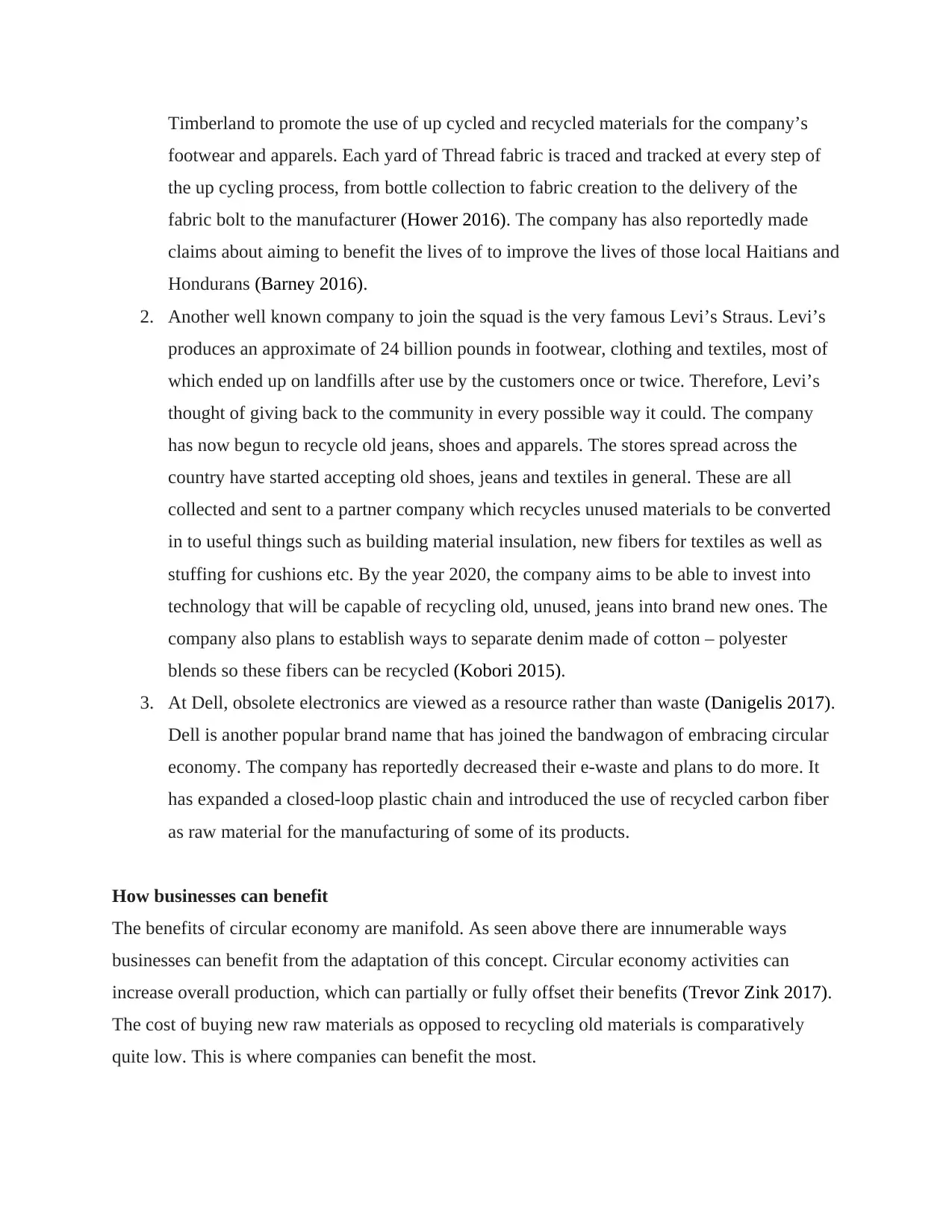
Timberland to promote the use of up cycled and recycled materials for the company’s
footwear and apparels. Each yard of Thread fabric is traced and tracked at every step of
the up cycling process, from bottle collection to fabric creation to the delivery of the
fabric bolt to the manufacturer (Hower 2016). The company has also reportedly made
claims about aiming to benefit the lives of to improve the lives of those local Haitians and
Hondurans (Barney 2016).
2. Another well known company to join the squad is the very famous Levi’s Straus. Levi’s
produces an approximate of 24 billion pounds in footwear, clothing and textiles, most of
which ended up on landfills after use by the customers once or twice. Therefore, Levi’s
thought of giving back to the community in every possible way it could. The company
has now begun to recycle old jeans, shoes and apparels. The stores spread across the
country have started accepting old shoes, jeans and textiles in general. These are all
collected and sent to a partner company which recycles unused materials to be converted
in to useful things such as building material insulation, new fibers for textiles as well as
stuffing for cushions etc. By the year 2020, the company aims to be able to invest into
technology that will be capable of recycling old, unused, jeans into brand new ones. The
company also plans to establish ways to separate denim made of cotton – polyester
blends so these fibers can be recycled (Kobori 2015).
3. At Dell, obsolete electronics are viewed as a resource rather than waste (Danigelis 2017).
Dell is another popular brand name that has joined the bandwagon of embracing circular
economy. The company has reportedly decreased their e-waste and plans to do more. It
has expanded a closed-loop plastic chain and introduced the use of recycled carbon fiber
as raw material for the manufacturing of some of its products.
How businesses can benefit
The benefits of circular economy are manifold. As seen above there are innumerable ways
businesses can benefit from the adaptation of this concept. Circular economy activities can
increase overall production, which can partially or fully offset their benefits (Trevor Zink 2017).
The cost of buying new raw materials as opposed to recycling old materials is comparatively
quite low. This is where companies can benefit the most.
footwear and apparels. Each yard of Thread fabric is traced and tracked at every step of
the up cycling process, from bottle collection to fabric creation to the delivery of the
fabric bolt to the manufacturer (Hower 2016). The company has also reportedly made
claims about aiming to benefit the lives of to improve the lives of those local Haitians and
Hondurans (Barney 2016).
2. Another well known company to join the squad is the very famous Levi’s Straus. Levi’s
produces an approximate of 24 billion pounds in footwear, clothing and textiles, most of
which ended up on landfills after use by the customers once or twice. Therefore, Levi’s
thought of giving back to the community in every possible way it could. The company
has now begun to recycle old jeans, shoes and apparels. The stores spread across the
country have started accepting old shoes, jeans and textiles in general. These are all
collected and sent to a partner company which recycles unused materials to be converted
in to useful things such as building material insulation, new fibers for textiles as well as
stuffing for cushions etc. By the year 2020, the company aims to be able to invest into
technology that will be capable of recycling old, unused, jeans into brand new ones. The
company also plans to establish ways to separate denim made of cotton – polyester
blends so these fibers can be recycled (Kobori 2015).
3. At Dell, obsolete electronics are viewed as a resource rather than waste (Danigelis 2017).
Dell is another popular brand name that has joined the bandwagon of embracing circular
economy. The company has reportedly decreased their e-waste and plans to do more. It
has expanded a closed-loop plastic chain and introduced the use of recycled carbon fiber
as raw material for the manufacturing of some of its products.
How businesses can benefit
The benefits of circular economy are manifold. As seen above there are innumerable ways
businesses can benefit from the adaptation of this concept. Circular economy activities can
increase overall production, which can partially or fully offset their benefits (Trevor Zink 2017).
The cost of buying new raw materials as opposed to recycling old materials is comparatively
quite low. This is where companies can benefit the most.
⊘ This is a preview!⊘
Do you want full access?
Subscribe today to unlock all pages.

Trusted by 1+ million students worldwide
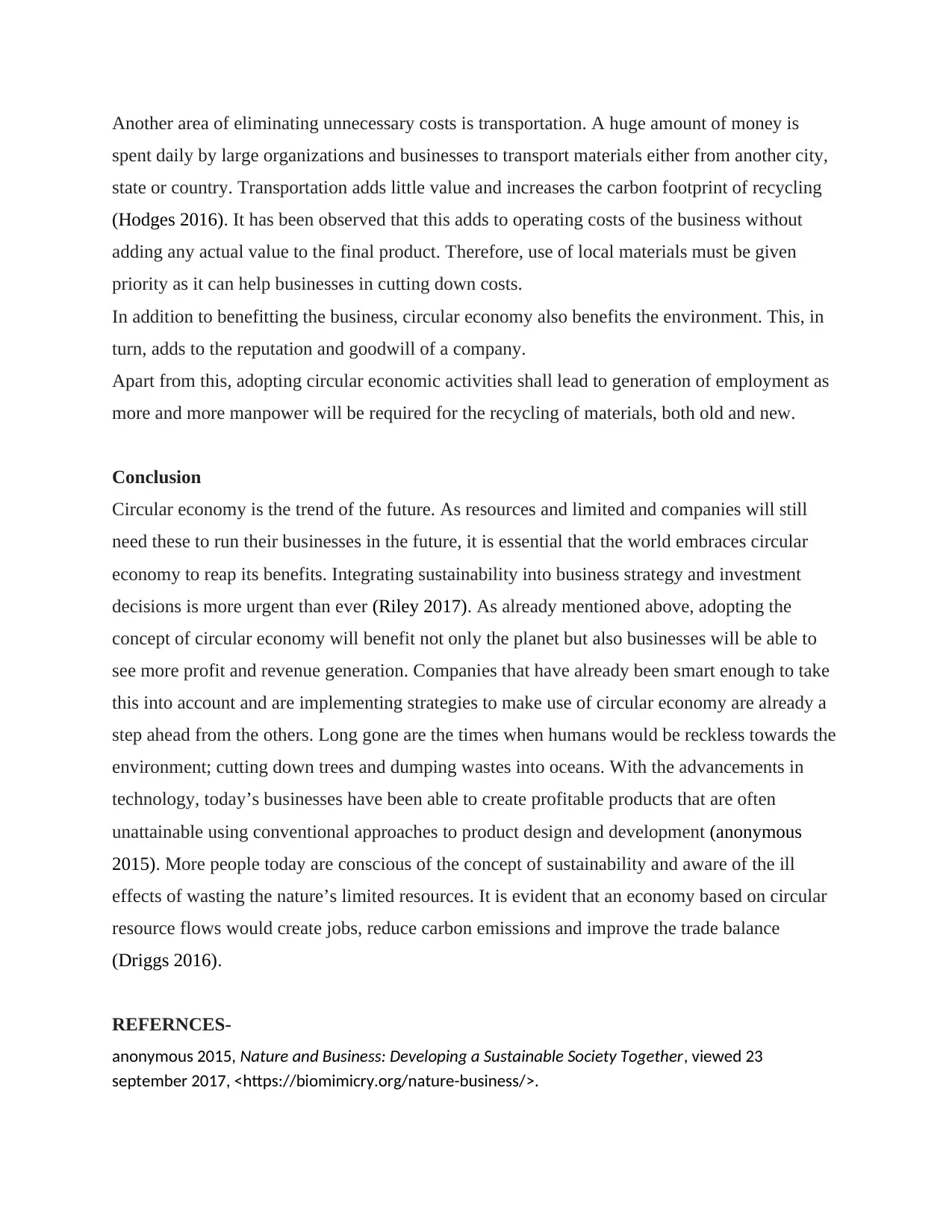
Another area of eliminating unnecessary costs is transportation. A huge amount of money is
spent daily by large organizations and businesses to transport materials either from another city,
state or country. Transportation adds little value and increases the carbon footprint of recycling
(Hodges 2016). It has been observed that this adds to operating costs of the business without
adding any actual value to the final product. Therefore, use of local materials must be given
priority as it can help businesses in cutting down costs.
In addition to benefitting the business, circular economy also benefits the environment. This, in
turn, adds to the reputation and goodwill of a company.
Apart from this, adopting circular economic activities shall lead to generation of employment as
more and more manpower will be required for the recycling of materials, both old and new.
Conclusion
Circular economy is the trend of the future. As resources and limited and companies will still
need these to run their businesses in the future, it is essential that the world embraces circular
economy to reap its benefits. Integrating sustainability into business strategy and investment
decisions is more urgent than ever (Riley 2017). As already mentioned above, adopting the
concept of circular economy will benefit not only the planet but also businesses will be able to
see more profit and revenue generation. Companies that have already been smart enough to take
this into account and are implementing strategies to make use of circular economy are already a
step ahead from the others. Long gone are the times when humans would be reckless towards the
environment; cutting down trees and dumping wastes into oceans. With the advancements in
technology, today’s businesses have been able to create profitable products that are often
unattainable using conventional approaches to product design and development (anonymous
2015). More people today are conscious of the concept of sustainability and aware of the ill
effects of wasting the nature’s limited resources. It is evident that an economy based on circular
resource flows would create jobs, reduce carbon emissions and improve the trade balance
(Driggs 2016).
REFERNCES-
anonymous 2015, Nature and Business: Developing a Sustainable Society Together, viewed 23
september 2017, <https://biomimicry.org/nature-business/>.
spent daily by large organizations and businesses to transport materials either from another city,
state or country. Transportation adds little value and increases the carbon footprint of recycling
(Hodges 2016). It has been observed that this adds to operating costs of the business without
adding any actual value to the final product. Therefore, use of local materials must be given
priority as it can help businesses in cutting down costs.
In addition to benefitting the business, circular economy also benefits the environment. This, in
turn, adds to the reputation and goodwill of a company.
Apart from this, adopting circular economic activities shall lead to generation of employment as
more and more manpower will be required for the recycling of materials, both old and new.
Conclusion
Circular economy is the trend of the future. As resources and limited and companies will still
need these to run their businesses in the future, it is essential that the world embraces circular
economy to reap its benefits. Integrating sustainability into business strategy and investment
decisions is more urgent than ever (Riley 2017). As already mentioned above, adopting the
concept of circular economy will benefit not only the planet but also businesses will be able to
see more profit and revenue generation. Companies that have already been smart enough to take
this into account and are implementing strategies to make use of circular economy are already a
step ahead from the others. Long gone are the times when humans would be reckless towards the
environment; cutting down trees and dumping wastes into oceans. With the advancements in
technology, today’s businesses have been able to create profitable products that are often
unattainable using conventional approaches to product design and development (anonymous
2015). More people today are conscious of the concept of sustainability and aware of the ill
effects of wasting the nature’s limited resources. It is evident that an economy based on circular
resource flows would create jobs, reduce carbon emissions and improve the trade balance
(Driggs 2016).
REFERNCES-
anonymous 2015, Nature and Business: Developing a Sustainable Society Together, viewed 23
september 2017, <https://biomimicry.org/nature-business/>.
Paraphrase This Document
Need a fresh take? Get an instant paraphrase of this document with our AI Paraphraser
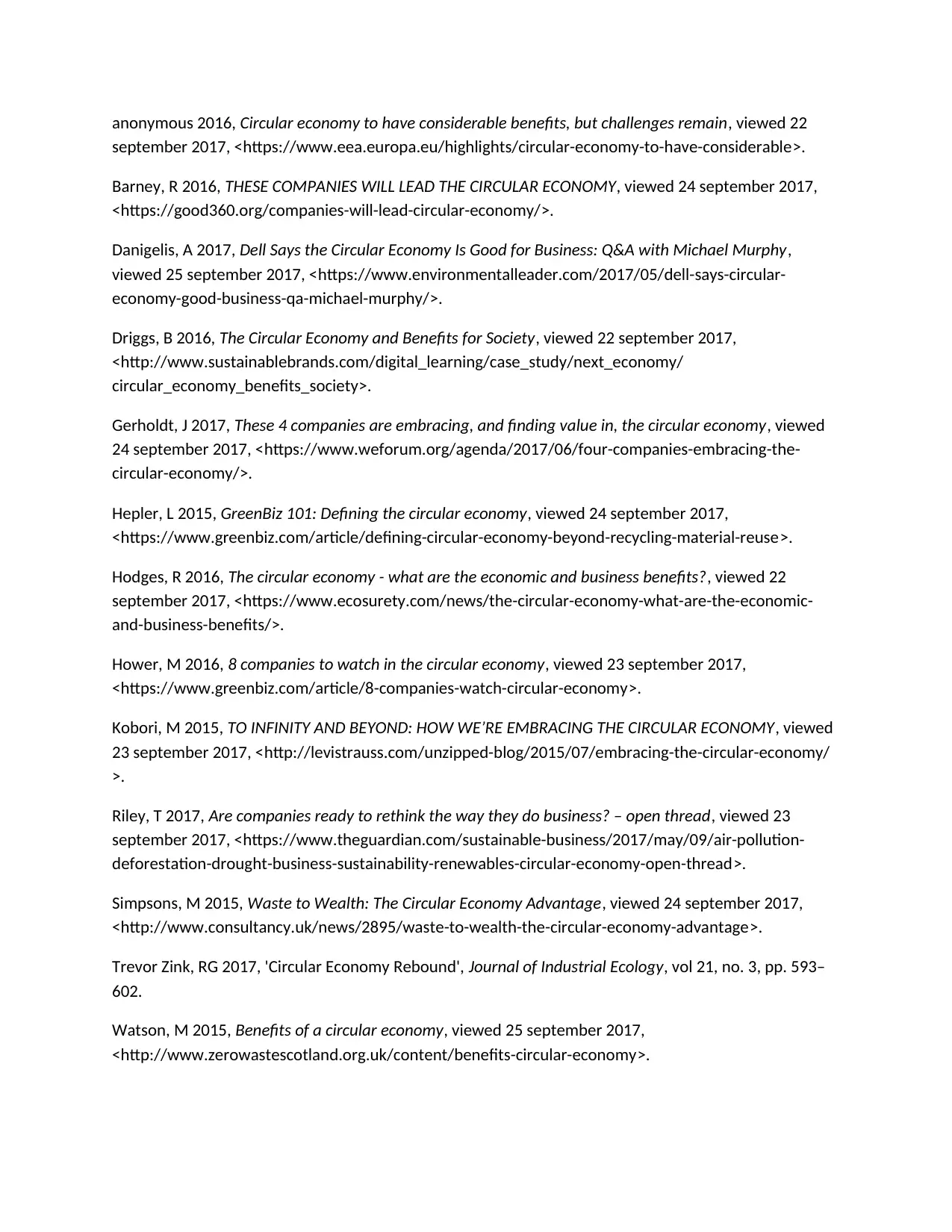
anonymous 2016, Circular economy to have considerable benefits, but challenges remain, viewed 22
september 2017, <https://www.eea.europa.eu/highlights/circular-economy-to-have-considerable>.
Barney, R 2016, THESE COMPANIES WILL LEAD THE CIRCULAR ECONOMY, viewed 24 september 2017,
<https://good360.org/companies-will-lead-circular-economy/>.
Danigelis, A 2017, Dell Says the Circular Economy Is Good for Business: Q&A with Michael Murphy,
viewed 25 september 2017, <https://www.environmentalleader.com/2017/05/dell-says-circular-
economy-good-business-qa-michael-murphy/>.
Driggs, B 2016, The Circular Economy and Benefits for Society, viewed 22 september 2017,
<http://www.sustainablebrands.com/digital_learning/case_study/next_economy/
circular_economy_benefits_society>.
Gerholdt, J 2017, These 4 companies are embracing, and finding value in, the circular economy, viewed
24 september 2017, <https://www.weforum.org/agenda/2017/06/four-companies-embracing-the-
circular-economy/>.
Hepler, L 2015, GreenBiz 101: Defining the circular economy, viewed 24 september 2017,
<https://www.greenbiz.com/article/defining-circular-economy-beyond-recycling-material-reuse>.
Hodges, R 2016, The circular economy - what are the economic and business benefits?, viewed 22
september 2017, <https://www.ecosurety.com/news/the-circular-economy-what-are-the-economic-
and-business-benefits/>.
Hower, M 2016, 8 companies to watch in the circular economy, viewed 23 september 2017,
<https://www.greenbiz.com/article/8-companies-watch-circular-economy>.
Kobori, M 2015, TO INFINITY AND BEYOND: HOW WE’RE EMBRACING THE CIRCULAR ECONOMY, viewed
23 september 2017, <http://levistrauss.com/unzipped-blog/2015/07/embracing-the-circular-economy/
>.
Riley, T 2017, Are companies ready to rethink the way they do business? – open thread, viewed 23
september 2017, <https://www.theguardian.com/sustainable-business/2017/may/09/air-pollution-
deforestation-drought-business-sustainability-renewables-circular-economy-open-thread>.
Simpsons, M 2015, Waste to Wealth: The Circular Economy Advantage, viewed 24 september 2017,
<http://www.consultancy.uk/news/2895/waste-to-wealth-the-circular-economy-advantage>.
Trevor Zink, RG 2017, 'Circular Economy Rebound', Journal of Industrial Ecology, vol 21, no. 3, pp. 593–
602.
Watson, M 2015, Benefits of a circular economy, viewed 25 september 2017,
<http://www.zerowastescotland.org.uk/content/benefits-circular-economy>.
september 2017, <https://www.eea.europa.eu/highlights/circular-economy-to-have-considerable>.
Barney, R 2016, THESE COMPANIES WILL LEAD THE CIRCULAR ECONOMY, viewed 24 september 2017,
<https://good360.org/companies-will-lead-circular-economy/>.
Danigelis, A 2017, Dell Says the Circular Economy Is Good for Business: Q&A with Michael Murphy,
viewed 25 september 2017, <https://www.environmentalleader.com/2017/05/dell-says-circular-
economy-good-business-qa-michael-murphy/>.
Driggs, B 2016, The Circular Economy and Benefits for Society, viewed 22 september 2017,
<http://www.sustainablebrands.com/digital_learning/case_study/next_economy/
circular_economy_benefits_society>.
Gerholdt, J 2017, These 4 companies are embracing, and finding value in, the circular economy, viewed
24 september 2017, <https://www.weforum.org/agenda/2017/06/four-companies-embracing-the-
circular-economy/>.
Hepler, L 2015, GreenBiz 101: Defining the circular economy, viewed 24 september 2017,
<https://www.greenbiz.com/article/defining-circular-economy-beyond-recycling-material-reuse>.
Hodges, R 2016, The circular economy - what are the economic and business benefits?, viewed 22
september 2017, <https://www.ecosurety.com/news/the-circular-economy-what-are-the-economic-
and-business-benefits/>.
Hower, M 2016, 8 companies to watch in the circular economy, viewed 23 september 2017,
<https://www.greenbiz.com/article/8-companies-watch-circular-economy>.
Kobori, M 2015, TO INFINITY AND BEYOND: HOW WE’RE EMBRACING THE CIRCULAR ECONOMY, viewed
23 september 2017, <http://levistrauss.com/unzipped-blog/2015/07/embracing-the-circular-economy/
>.
Riley, T 2017, Are companies ready to rethink the way they do business? – open thread, viewed 23
september 2017, <https://www.theguardian.com/sustainable-business/2017/may/09/air-pollution-
deforestation-drought-business-sustainability-renewables-circular-economy-open-thread>.
Simpsons, M 2015, Waste to Wealth: The Circular Economy Advantage, viewed 24 september 2017,
<http://www.consultancy.uk/news/2895/waste-to-wealth-the-circular-economy-advantage>.
Trevor Zink, RG 2017, 'Circular Economy Rebound', Journal of Industrial Ecology, vol 21, no. 3, pp. 593–
602.
Watson, M 2015, Benefits of a circular economy, viewed 25 september 2017,
<http://www.zerowastescotland.org.uk/content/benefits-circular-economy>.

⊘ This is a preview!⊘
Do you want full access?
Subscribe today to unlock all pages.

Trusted by 1+ million students worldwide
1 out of 6
Related Documents
Your All-in-One AI-Powered Toolkit for Academic Success.
+13062052269
info@desklib.com
Available 24*7 on WhatsApp / Email
![[object Object]](/_next/static/media/star-bottom.7253800d.svg)
Unlock your academic potential
Copyright © 2020–2025 A2Z Services. All Rights Reserved. Developed and managed by ZUCOL.





